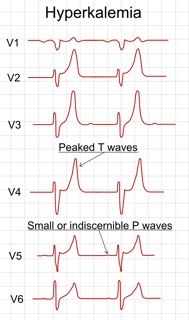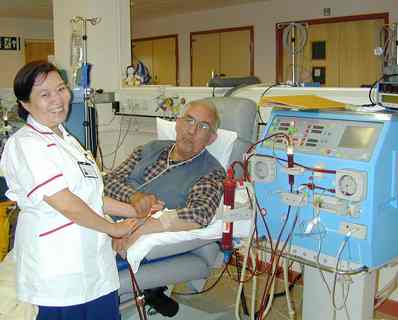Hyperkalemia
What is Potassium?
Potassium is a metal with a chemical symbol of K (kalium). Like sodium, it is silver to white in color. Potassium is very reactive to water and may cause combustion of the hydrogen component.
Potassium is naturally present as ionic salts as part of several minerals. It is also found in seawater like sodium. Potassium is very abundant in plants and has high concentrations in almost all fruits such as bananas, apples, pear, etc.
Potassium is essential for body processes of human beings. It is one of the most important electrolytes in conducting nerve impulses especially in the heart.
Potassium Functions
Potassium is a positively charged electrolyte and the most abundant cat-ion in the intracellular space amounting to 150 mEq/L. It occurs in the body in same amounts with chlorine and sulfur. Serum potassium level is from 3.5 to 5.0 mEq/L. Potassium is essential to various body functions. Potassium functions in the body through:
- Nerve impulse transmission in the nervous system – Impulse transmission occurs because of the action of the sodium-potassium ATPase pump. During this process, ATP pumps sodium out of the intracellular space and potassium into the cell. Because of this, it creates electrical gradient and is important for the hyperpolarization of the neurons for another nerve impulse transmission.
- Regulates myocardial contractility – One of the most important functions of potassium is to initiate action potentials for the heart muscles. Abnormalities in the potassium levels are very crucial because it can affect the contractility of the heart.
- Stabilizing osmosis between the extracellular and intracellular space.
- Regulates smooth and skeletal muscle contraction
- Prevents prolonged muscle contraction.
- Maintains fluid and electrolyte levels.
- Any elevation or reduction in serum potassium levels is life-threatening because it affects the myocardial contractility, which may lead to heart block.
What is Hyperkalemia?
Hyperkalemia is an electrolyte imbalance resulting from an increase in the serum levels of potassium higher than 5.0 mEq/L. Severe elevations in the serum level of potassium require emergency medical treatment to prevent fatal arrhythmias. Most of the potassium concentration inside the body is found in the intracellular space, so an increase in the blood level of potassium significantly leads to changes in all of its functions.
Elevation of serum levels from 5.1 to 6.0 mEq/L is considered mild hyperkalemia. Serum levels from 6.1 to 7.0 mEq/L indicate moderate hyperkalemia and levels higher than 7.0 mEq/L signify severe form of hyperkalemia. Mild Hyperkalemia may not cause heart arrhythmias, but monitoring should be instituted to detect further rise of the serum electrolyte level. Moderate hyperkalemia may be associated with changes in the ECG readings whereas severe hyperkalemia may lead to cardiac arrest.
Hyperkalemia is a very serious condition and mortality rate in severe hyperkalemia is as high as 70%
Causes and Risk Factors
Hyperkalemia is not a single phenomenon, but an effect of several medical conditions leading to increase in potassium levels.
Kidney Disease
The kidneys normally regulate the excretion of potassium to prevent excess levels in the body. Any problems relating to the kidney function may definitely lead to hyperkalemia. Specific causes include:
- Chronic kidney failure
- Acute kidney disease
- Obstructive uropathy
- Glomerulonephritis
- Kidney rejection after transplant
Aldosterone Deficiency
Aldosterone also plays an important role in potassium excretion. As aldosterone retains sodium, it also leads to potassium excretion because of a negative relationship between the two cat-ions. Conditions leading to a decrease in aldosterone production lead to hyperkalemia. These include primary adrenal insufficiency, hypoaldosteronism and congenital adrenal hyperplasia.
Increase in Potassium Release
Other conditions that lead to hyperkalemia are those that release potassium out of the cells and into the extracellular compartment such as:
- Tumors
- Burns
- Hemolytic reactions
- Metabolic acidosis
- Severe infection
- Surgery
- Massive blood transfusions
- Other forms of traumatic injury
However, normal kidneys are able to excrete the high amounts of potassium in the blood. These conditions usually lead to hyperkalemia when kidney function is also impaired. Increased dietary intake of potassium may not also result to hyperkalemia when the kidneys are intact.
Medications
Administration of medications such as potassium-sparing diuretics, ACE inhibitors, and intravenous potassium chloride also increases the serum potassium concentration. Over dosage from digoxin also causes excessive release of potassium into the intravascular space.
Potassium is one of the drugs administered during lethal injections. The administration of potassium chloride is the one which results to death because of cardiac arrest.
Signs and Symptoms
Signs and symptoms of hyperkalemia include:
- Tachycardia occurs initially followed by bradycardia
- ECG changes
- Ectopic beats
- Palpitations
- Hypotension
- Nausea
- Diarrhea (compensatory mechanism to eliminate excess potassium)
- Fatigue
- Paresthesia or tingling sensations
- Muscle weakness, flaccid paralysis
- Muscle cramps
- Oliguria or anuria (scanty or absence of urination)
- Cardiac arrhythmia in severe cases
Signs and symptoms are usually not apparent in mild forms of hyperkalemia. Gradual rise in potassium levels are also not noticeable until serum levels reach 7.0 mEq/L.
Diagnosis
Diagnostic tests include:
Potassium Determination
Diagnosis of hyperkalemia involves electrolyte determination to examine extent of elevation. Usually, blood tests are repeated because an elevated potassium level during the first test may be caused by hemolysis of the blood extracted.
Electrocardiography (ECG)
A 12-lead ECG is usually done to assess affectation of the heart and examine presence of heart arrhythmias especially in moderate to severe cases of hyperkalemia.
ECG readings for severe hyperkalemia may reveal peaked, narrow T wave, widened QRS complex and flat P wave (as a result of heart block).
In an ECG strip, P waves represent atrial depolarization, QRS complex represent ventricular depolarization and T waves represent ventricular repolarization. The most important indicator of hyperkalemia is peaked T waves. A high level of potassium causes excess repolarization as seen in peaked T waves. Because of low sodium levels, there is slow conduction of electrical waves as manifested by a flat P wave, widened QRS complex, depressed ST segment and widened PR interval. The image below illustrates a hyperkalemic ECG finding:

Electrocardiography of a patient with Hyperkalemia
Renal Ultrasound
Renal ultrasound is also done to check any damage to the kidneys.
Other tests
Diagnostic exams that evaluate the renal function are done such as blood urea nitrogen and creatinine to rule out kidney etiology.
Management (Treatment)
Treatment for hyperkalemia involves the excretion of the excess potassium in the body along with correcting the signs and symptoms. Managements include:
Stabilizing Heart Contractility
Administration of calcium chloride or calcium gluconate regulates the resting membrane potential in heart muscles, which prevents fatal arrhythmias.
Temporary Lowering of Potassium Levels
Treatments aim at decreasing the blood serum level of potassium by shifting it back into the cells. These treatment options are done for emergency management of hyperkalemia. The action is usually short-acting, which requires more effective lowering of the potassium levels. These measures include:
Intravenous Insulin Administration- Insulin promotes the shifting of potassium back into the cells.
Sodium bicarbonate infusion-Sodium has an inverse relationship with potassium. Increasing sodium levels in the blood shifts potassium into the cells via the sodium potassium ATPase pump
Salbutamol Nebulizer- Beta adrenergic drugs also promote shifting of potassium into the cells.
Hemodialysis
Severe hyperkalemia requires dialysis to eliminate potassium in cases of permanent damage to the kidneys.

Diuretics
Loop diuretics specifically Furosemide increases the urinary excretion of potassium.
Sodium Polystyrene Sulfonate
Kayexalate is an example of this drug which promotes excretion of potassium through bowel elimination. It is usually administered via oral or rectal route.
Complications
Patients may eventually develop the following complications:
- Cardiac Arrhythmias
- Cardiac Arrest
- Neuromuscular deficits
- Mild to moderate hyperkalemia has good prognosis whereas patients with severe hyperkalemia may experience cardiac arrest if treatment is not started early.
Prevention
Prevention of hyperkalemia involves correct administration of medications such as digoxin, diuretics, and ACE inhibitors. Limiting potassium intake is also important to patients with kidney problems to prevent excess retention of potassium.